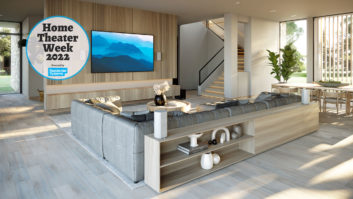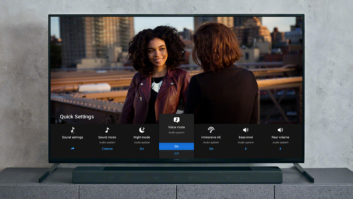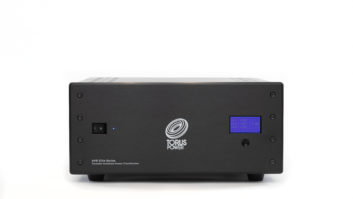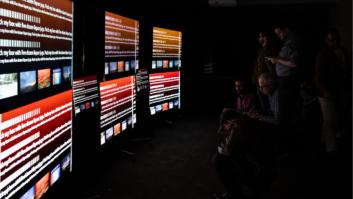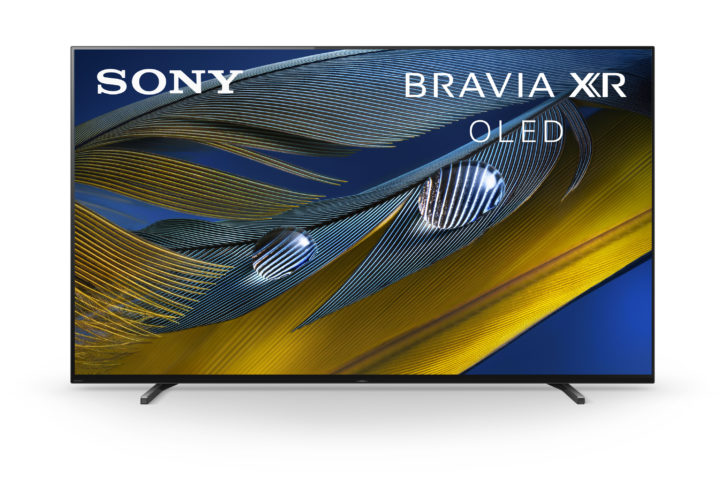
Love it or hate it — or probably, most accurately, love it and hate it — one of my highlights of attending CES is getting to see all of the latest displays being introduced. At CES, you not only get to see the crazy one-off prototypes of technologies under development (remember that 10,000-nit, 85-inch 8K HDR prototype Sony bowed in 2018?), you also get a glimpse at the new models you will be installing in the upcoming year. And no matter how good you think last year’s model was, it seems video manufacturers somehow always manage to find a way to hit a new performance benchmark with each succeeding generation.
While the pandemic robbed us of an in-person CES this year (Yay? Boo?), that didn’t stop Sony from releasing an entirely new lineup of displays for 2021, with the biggest addition being the introduction of a brand-new level of video processing called Cognitive Processor XR, which is featured in its premium LED and OLED offerings.
Video processing has always been the not-so-secret sauce behind Sony’s terrific picture quality, and Sony is claiming these new XR-equipped sets are the world’s first TVs to feature “Cognitive Intelligence,” which differs from artificial intelligence by adding a “thinking human element.”
As TVs become increasingly larger, this kind of processing becomes more important, as we need to focus on parts of the screen rather than the entire screen (think of sitting in the front row of a theater), which is how we view the real world. The XR processor functions similarly to the human brain and eyes when analyzing images, dividing the screen into hundreds-of-thousands of zones, identifying objects as human’s would see them, and then prioritizing processing to those focal point items. These prioritized items are cross-analyzed for color, contrast, brightness, and motion, and then enhanced by applying the most processing, for the sharpest, brightest, clearest images possible. All accomplished for all 8-million-plus-pixels in every video frame.
For 2021, Sony has two series of displays featuring self-emissive OLED technology, the A80J and A90J. Both support TV-led Dolby Vision and Netflix Calibrated mode, and are IMAX Enhanced certified and CalMan Ready. The A80J includes sets in 55, 65, and 77 inches, while the flagship Master Series A90J offers 55-, 65-, and 83-inch models.
Standing at the sweet spot of these options is the XR65A80J Sony sent for review. On top of the new Cognitive XR processor, this features other Sony technologies like XR Triluminos Pro for vibrant and accurate colors and XR OLED Contrast for deep blacks and bright whites, along with access to Sony’s exclusive new BRAVIA Core high-quality streaming service.
Appearance
Sony regularly tweaks the external appearance on its new models, and the new XR65A80J is no different. Those looking to install the TV on its included tabletop feet will appreciate the new three-way, multi-position stand design. As you’d guess, this means the feet can be positioned in three different ways: wide, narrow, and raised for use with soundbars. When positioned normally, the bottom of the display is raised a scant 7/8-inch, while the soundbar position lifts the bottom of the screen 2.75-inches off the deck. One of my complaints with the XBR65X950H I reviewed previously was the TV’s lean back and lack of stability of the “premium blade” stand design, but this stand feels far more stable. Of course, most of the TVs we sell/install will likely be wall-mounted, and all sets in the A80J line are VESA 300×300.
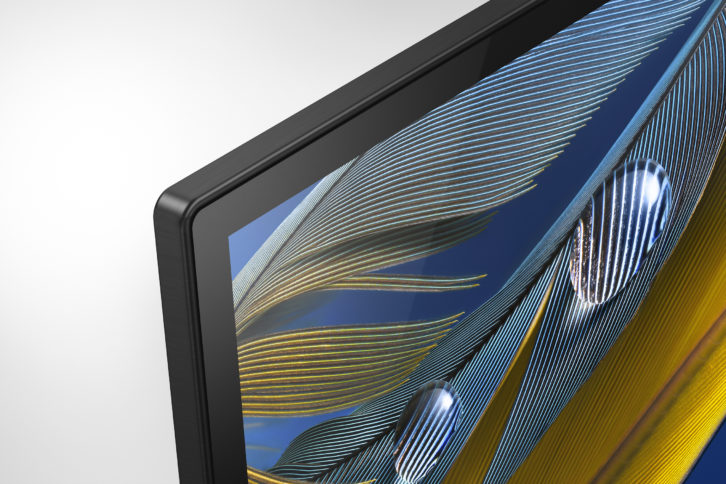
The set is attractive and has a luxury appearance when turned off, with a narrow aluminum bezel that is titanium-grey colored and smoothly rounded at the corners. There is about a 1/4-inch black border between the display and the frame edge, and then about a 3/4-inch glossy black base at the bottom. Occasionally, I got reflections from lights behind me from this glossy bottom portion, but never enough to be a bother. The screen itself has a matte finish, which helps to diffuse reflections.
Inputs are in two sections on the back, with some on the side making for easier end-user access, and more on the bottom. All inputs are smartly positioned so as to not impede wall-mounting. There are a total of four full bandwidth HDMI 2.0b connections, with HDMI 3 and 4 supporting next-gen HDMI 2.1 4K 120 Hz connections (HDMI 3 also supports eARC). Additionally, there are three USB connections, a mini-jack that accepts composite video and analog audio, a mini-jack audio out, and a Toslink digital out. On top of built-in 2.4/5G Wi-Fi, the set also includes an Ethernet connection, as well as RS-232 and IR inputs, so no need for an emitter to mar the clean front panel. The set also has Bluetooth A2DP headphone support, which is becoming a more requested feature.
Also new for all 2021 Sony TVs is a built-in ATSC 3.0 (NEXTGEN TV) tuner. This is currently served by a dozen or so markets across the nation, of which (sadly) Myrtle Beach, SC, is not yet one.
The analog AV mini-jack also shares labeling for a curious new input called “S-Center Speaker In,” which I’ll discuss in greater detail in the audio section, but just to be clear: The A80J series CANNOT serve as a center speaker in a traditional audio system. (That feature is still reserved for the step-up A90J panels.)
Smart TV and Control
Sony smart TVs have been running on Android for some time, but another big change here is the move to a newly designed Google TV. This builds on Android to provide a simplified entertainment experience for easier browsing and discovering what to watch. I found this to have a quick response, letting me quickly jump in and out of different apps or menus with near-seamless transition between smart services without any load times. You can also customize and arrange the home screen, choosing what apps to display and sorting the order and modifying the quick-access settings bar along the bottom to quickly jump into things like picture modes, settings, etc. It also supports a giant array of apps.
On the app front, I mentioned what a bummer it was that Sony doesn’t support the Spectrum app (very popular in my territory) and that Dolby Atmos audio isn’t supported by the TV’s Disney+. Since Google develops the OS and the apps, they are in charge of this, and all Sony can do is relay comments/concerns to Google. So, consider them relayed.
One big feature of the new XR-equipped displays is the ability to access a new Sony app called BRAVIA Core. In fact, this app comes pre-installed on the sets, and there is no other way to access it. To access the Core content, you need to register the TV and enter a unique unlock code, which is all done via the TV itself. Core currently includes one or two years of unlimited streaming along with 5 or 10 credits (depending on model purchased) with no current way to add more time or credits. (Sony is working on a “phase two” option for customers that would like to extend this time or purchase more credits.)
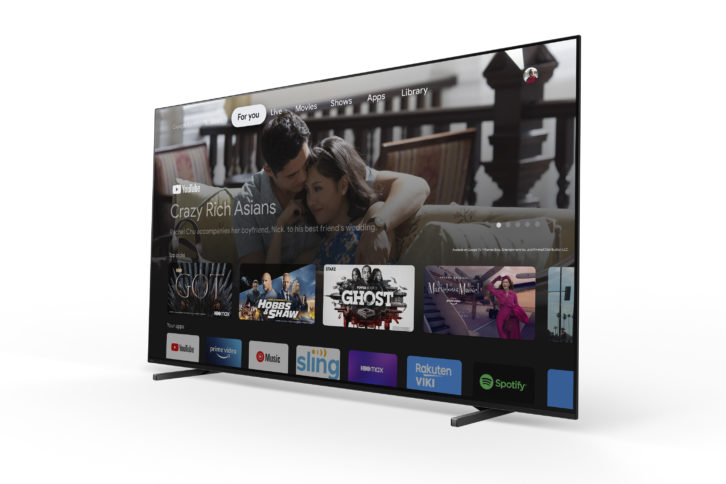
The big deal about Core is a new “Pure Stream” mode that can deliver way higher quality video than traditional streaming services; upwards of 80 Mbps, which is nearly on par with the output of a 4K Blu-ray player and about five-times greater than what Netflix typically delivers. As expected, the library of streamed titles is exclusively from Sony Pictures Home Entertainment, with currently about 600 titles on the service, including the single largest library of IMAX Enhanced titles. Interestingly, the IMAX Enhanced titles didn’t automatically trigger the IMAX Enhanced mode, rather making you select it from the Picture Modes, and enabling the multi-channel IMAX Enhanced DTS audio output requires a bit of (oh-so-worth-it!) menu searching.
I saw several additions to the library in the time I owned the set, proving Sony’s promise that newer content will continue to be made available. Also, the availability of the “free” unlimited streaming titles changes. We started watching two “free” films — the 2014 Annie remake and Only the Brave — but after returning to resume them a few days later, they were no longer “free” and would have required one of our five credits to view.
Like my experience with the XBR65X950H, the included remote here is quite useful. It also has received a revamp and now includes four “hot buttons” for accessing popular streaming services, including Netflix, Prime Video, YouTube, and Disney+, which was a big hit for my five-year-old. The remote retains the built-in Google Assistant voice control microphone, and can pair with/control certain set-top boxes (Comcast, DISH, DirecTV, TiVo Bolt, Charter, and Spectrum). It also retains Sony’s maddening habit of no backlighting, so you win some, you lose some.
Beyond Google, Sony supports Alexa integration and has drivers for the majority of automation systems, including an option in the Network settings to turn on an “announcement” for Control4’s SDDP. Once engaged, the TV appeared in the Composer (Control4’s programming software) device list to easily integrate into my project. Along with Chromecast, the TV supports Apple Airplay2 and HomeKit integration, letting iOS users easily screen-mirror via AirPlay to the TV, allowing a fast and simple way to share photos and videos from an iPhone or iPad without any other hardware.
Audio Quality
My typical response to, “How good is the TV’s audio?” is usually, “You buy the TV for its picture, not its sound.” But the sound on this OLED is a different animal, as the A80J models incorporate Sony’s Acoustic Surface Audio+ technology, using transducers to turn the entire screen into a speaker. Also upgraded from last year’s OLEDs is a new front-firing subwoofer for better bass. The TV can use the remote’s built-in microphone to perform an in-room “Acoustic calibration” to further tweak the sound, adjusting for the listener’s in-room relationship to the TV and then using phase manipulation to deliver a more 3D sound experience.
The result is surprisingly decent audio quality — far better than from traditional displays where the tiny speakers often fire downward or back into the wall. You also keep some decent separation and good sense of localization because the sound is literally coming from the screen. It also generated decent volume levels, hitting 80 dB SPL at my seating distance about 12-feet from the screen.
While every TV will benefit from an outboard audio system — whether that’s a soundbar or a full surround system — the A80J has enough output that it could stand on its own, especially in a bedroom.
Related:
Now for that S-Center Speaker In connection mentioned earlier. About half-way through my review of the TV, Sony issued a press release announcing two new premium speaker systems, the HT-A9 and the HT-A7000 soundbar. These new speakers have outputs that connect to this S-Center connection, allowing the TV’s speaker to play certain sounds and frequencies while connected to the bar, delivering a more immersive audio experience with sounds better matching their on-screen locations.
In order to test this out, Sony sent me a sample of its new HT-A7000 bar (along with the optional new SW-SW5 subwoofer and SA-RS35 surround speakers, all of which will be reviewed in an upcoming issue). Connecting the S-Center output definitely raised the audio experience — literally — and delivered a more cinematic feel with more height to the presentation. I wouldn’t call it “game changing,” but I’d definitely call it an improvement.
Picture Quality
I’m not going to waste time burying the lede; the Sony XR65A80J is flat-out the best-looking TV I’ve experienced. The pure, clean, absolute blacks coupled with the vibrant, bright colors produced incredibly cinematic images that never failed to impress.
The importance of clean, inky blacks in delivering a truly reference, high-contrast picture can’t be overemphasized, especially when watching in a low/no-light environment. OLED is known for its absolute black levels, and these never failed to impress with the A80J. The black is so black, I would often double-check to make sure the TV was actually off instead of just not getting a signal.
People regularly ask if OLEDs are bright enough to compete with ambient lighting in a typical room, and with the A80J I’d have to say definitely, as watching during the day was never an issue, no matter the content. My wife and I started watching the Netflix zombie-apocalypse series Black Summer, and episode three, “Summer School,” has characters trapped in a school. There is a scene where characters are in a mostly all-white, porcelain and tile, very brightly lit bathroom that put to rest any concerns about OLED not having enough light output or being able to deliver an image with high APL (Average Picture Level).
Sony claims the “Custom” picture mode delivers the most accurate image out of the box, automatically defeating many of the set’s extra picture “enhancements”; however, many viewers will probably enjoy some level of “tweaking.” Settings like Live Color, which can deliver more saturated images, and Adv. Contrast Enhancer, that delivers more “pop,” offer off-low-medium-high levels to help adjust the picture to your viewing preference, without going to the blown-out “Torch mode” look, which is the set’s “Vivid” setting.
I watched hours of content on the display, ranging from 4K Kaleidescape, to streaming content across a variety of providers, including Bravia Core, to HD programming via DISH, and images were consistently fantastic. Even my family — who are usually disinterested by the gear I’m reviewing — commented on what an improvement the OLED was.
Whether it was due to the new XR processor or not, close-ups bristled with detail, showing pinpoint stitching in fabric, single strands of hair, and every wrinkle, line, and pore in actors’ faces. Pausing a scene as the camera flew over the Olympic village in Tokyo showed far less noise and more stable line structure when compared to other sets in my home. And the motion processing in the A80J delivered terrific images, motion, and color regardless of the sporting event.
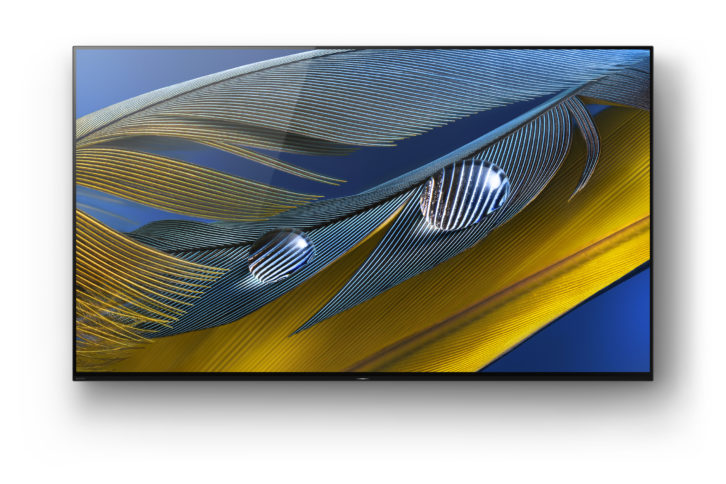
We have been rewatching Lost with my 14-year-old, and I was repeatedly stunned by how good the upconverted DVD video quality looked. Close-ups often had near-4K level quality, with incredibly clean and noise-free blacks and virtually no banding. Also, the clarity and lack of noise — specifically around the opening credits — was significantly superior when compared to viewing on my JVC NX7 projector.
Of course, the set looks its best when fed 4K HDR (preferably Dolby Vision) content, and we watched multiple movies, including new releases Fast & Furious 9, A Quiet Place Part II, and Jungle Cruise. While straining even the widest suspension of disbelief, F9 does at least look fantastic, and the A80J showed off all the detail, specifically the long-range shots over London and Edinburgh, as well as the bright lighting that popped in dark buildings, tunnels, or garages, or the texture in Vin Diesel’s ever-present ribbed muscle-T’s. While the opening of Jungle Cruise looked a bit soft and hazy on my NX7 projector, the A80J revealed that it was just a haze of smokiness and diffuse light filtering through windows into the lecture hall, again letting you revel in the dark jungle scenes illuminated by lanterns or firelight.
One of the most impressive demo-scenes I saw was actually the end credits of Space Jam: A New Legacy streamed on HBO Max. Here there is a background of pure black with bright, sharp credits interspersed with images bordered in neon hues. The image was just so clean, so sharp, had such bright colors, and so much contrast that it demonstrated all the A80J’s strengths.
On the gaming front, the TV includes two next-gen HDMI 2.1 inputs (3 and 4). These currently handle 4K at 120 Hz and will support ALLM (Automatic Low Latency Mode). VRR (variable refresh rates) will be supported in a future firmware update. Sony stressed that the sets do not make any adverse color, brightness, or contrast changes when in “Game” mode, remaining true to the company’s philosophy of always delivering the creative intent of the content creator.
Flagship A90 Differences
As great as the A80J is, it isn’t the flagship. That title belongs to Sony’s A90J Master Series OLED sets. But, as I write this, the 65-inch XR65A90J carries a $1500 premium over the XR65A80J. Inevitably this will raise the question of whether the upgrade is “worth” it.
The biggest difference is that the A90J features a more efficient OLED panel and a bonded rear panel aluminum heat sink that allows the engineers to drive the TV harder to get more overall light output, resulting in higher APL (Average Picture Level), as well as brighter peak highlights.
The set also features some other upgrades, like a new dual-actuator audio system for better channel separation, hands-free voice control (microphone built into the TV), a different tabletop stand design, a white balance sensor added to the ambient light sensor, a premium backlit remote control, and the ability to use the panel as a center channel speaker.
Considering that most of these “upgrades” — better internal speakers, better remote, different tabletop stand, built-in microphone, center speaker mode — likely won’t be employed by most of our installations, that makes the upgrade a pricey proposition.
For someone who only wants the best, and wants the bragging rights of being able to say, “I’ve got the very best TV on the market!” I feel totally confident in upgrading him or her to the A90J. For everyone else, enjoy the awesome glory that is the A80J, and use the extra Benjamins saved to invest in that new Sony soundbar or other audio upgrade. While it is a step-up over a flagship LED, it clearly delivers the performance goods. And if you want to sell more premium OLED displays, simply put one on your showroom floor and just let people take a look at it.
877-865-7669; SONY.COM
Kudos: Reference picture quality; outstanding black levels and color reproduction; fantastic motion handling
Concerns: Wish Disney+ app supported Dolby Atmos
Product Specs:
- OLED 4K UltraHD self-emissive technology
- Cognitive Processor XR
- Access to Sony BRAVIA Core streaming (includes 12-months access and five movie credits)
- IMAX Enhanced Certified, Dolby Vision, Netflix Calibrated, CalMan Ready
- Google TV OS with microphone built into remote
- Acoustic Surface Audio+ technology uses screen as a speaker
- Inputs: Two HDMI 2.0b inputs, two HDMI 2.1 inputs supporting 4K/120 (HDMI 3 supports eARC), three USB, mini-jack composite and analog audio/S-Center Audio In, Ethernet, mini-jack IR, mini-jack RS-232; Outputs: mini-jack analog audio, Toslink digital
Dimensions: 57 1/8 x 33 x 2 1/8 inches (WxHxD without stand)
Weight: 49.2 pounds
